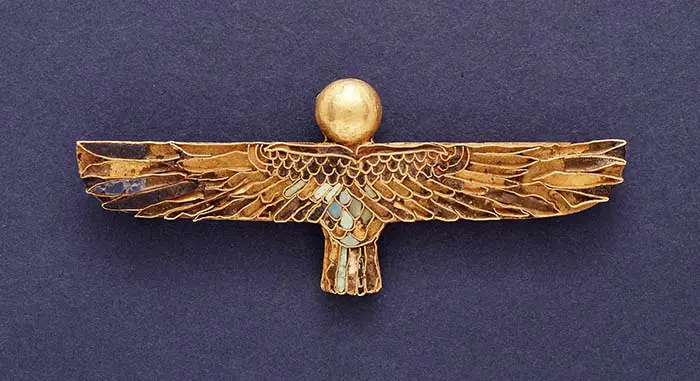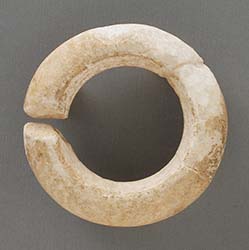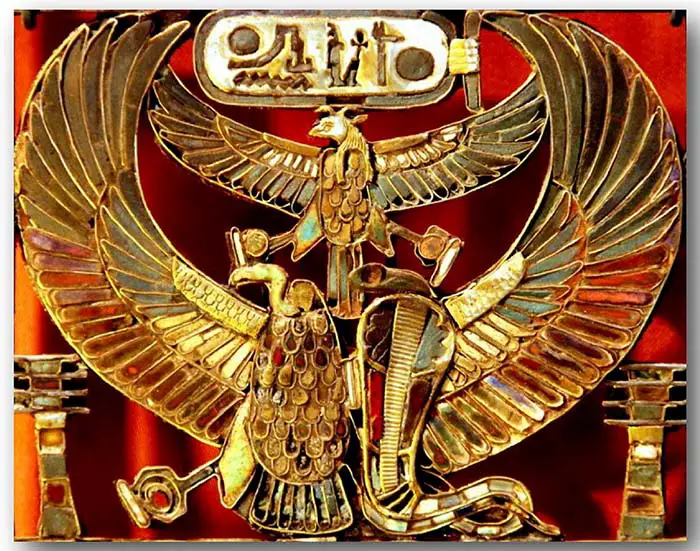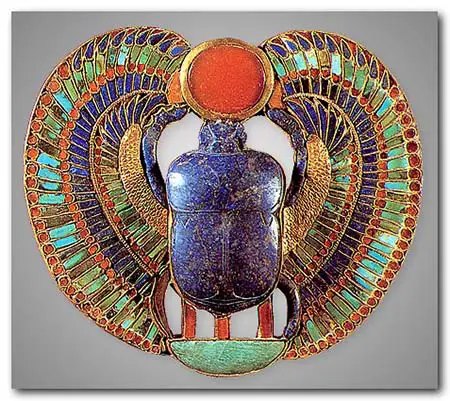Ancient Egyptian Jewelry
Except for the slaves, all ancient Egyptians wore heavy, brightly colored jewelry and it was highly valued. Not only did jewelry reflect the wealth and social status of its wearer, it was thought to help ward off evil spirits, both here and in the afterlife.
Men, women, and children routinely adorned themselves with the best jewelry they could afford in an assortment of styles. An abundance of jewelry indicated that the gods were happy with the wearer and was thus blessing him or her.
The dead were entombed with their own jewelry as well as items belonging to family members, which helped ensure their success in the afterlife. Most ancient Eqyptians wore collar pieces which ranged from extravagant to simple, depending on the status of the wearer, and wealthier Egyptians would often have their most elaborate collar pieces entombed with them.

© Peter Roan - Broad Collar
Except for the pharaoh's jewelry, less emphasis was placed on the type of metal used in the jewelry than it was on the type(s) of stone(s) that adorned it. Some stones and colors used in ancient Egyptian jewelry were thought to have special significance to the wearer and were therefore more popular. Certain colors were thought to provide health benefits, which accounts for the prodigious use of color in ancient Egyptian jewelry.
Certain items of jewelry, such as the scarab, carried religious significance to the ancient Egyptians. The scarab represented rebirth, so it was essential to have one or more scarabs adorning the deceased in order to ensure reincarnation to the next level. The owner's name was inscribed on the stone so that his spirit would know it was his.

© Ashley Van Haeften - Scarab Beetle
Although children under 6 years old usually didn't wear clothing, they wore jewelry. The amount and quality of their ancient Egyptian jewelry depended on their parents' status, but all children wore jewelry unless they were slaves.
Materials Used in Ancient Egyptian Jewelry
Wealthier classes used primarily gold and some copper for their ancient Egyptian jewelry, while lower classes used mainly copper. Silver was scarce to unknown in ancient Egypt since there were no silver mines at hand. By combining various elements with gold, jewelers created other colors such as rose, grey, and reddish brown. The addition of tin to copper yielded bronze, which was both harder and much more attractive than tin.
Wealthier Egyptians made abundant use of precious and semi-precious stones, with lapis lazuli being their favorite. Its deep blue hue denotes honor, royalty, wisdom, and truth; King Tutankhamen's tomb was liberally inlaid with lapis lazuli.

© Ashley Van Haeften - Gold Amulet with Stone Inserts
Polychrome glass was used for colorful jewelry and beads, as well as for pottery, in vivid hues of green, red, yellow, and blue. Other gemstones used in ancient Egyptian jewelry included:
- Emeralds, which were for immortality and fertility
- Malachite, which promoted healing
- Garnet, which symbolized the extremes of anger and fire, and victory and life
- Turquoise, which symbolized life and happiness
- Carnelian, which was believed to purify the blood, symbolized stability and protection
- Obsidian, which symbolized death
- Amethyst, which denoted royalty
Those of lower birth or those who had limited means used bone and stone for their jewelry, and buttons were very popular. This prompted the jewelers of the time to perfect the craftsmanship of artificial gemstones. Fake pearls, emeralds, and tiger's eye stones became almost indistinguishable from the real thing. Buttons were used strictly for decoration, they served no function other than that.
Types of Jewelry
Ancient Egyptians loved to adorn their bodies with jewelry. Due to the hot, arid climate, most clothing was simple and lightweight, so jewelry allowed the ancient Egyptians the means to display their wealth and status as well as protect themselves from evil spirits.
Jewelry was worn not only for adornment and protection, but for legal authentication. Each man would have a signet ring which bore his family emblem. Emblems were usually animals such as a griffin, a hawk, a lion, a scorpion, and so forth. The rings were ornately engraved so that each man's ring was unique to him.

© Tim Evanson - Signet Ring of Amenhotep II
Rather than signing official documents, they were sealed by use of the man's ring. Women didn't wear or own signet rings. Wealthy individuals had stones and/or engravings on their signet rings but a poor man had a simple ring, made usually of copper or bronze.
Other types of ancient Egyptian jewelry include:
- Ankle bracelets
- Armbands
- Bracelets
- Brooches
- Collar pieces
- Crowns
- Diadems
- Earrings
- Girdles
- Necklaces
- Pectorals
- Rings
Armbands were usually worn around the upper arm, one or more bracelets were worn on the forearm. Collar pieces varied in size from a simple, chain-like adornment to a wide, lavishly ornamented collar that extended across the shoulders. Some of the collar pieces were very heavy and needed a counterweight in the back in order to keep them in place.
Girdles were chains or mesh items that were worn around the waist or lower waist and frequently were adorned with stones. Necklaces and rings could be as simple or as elaborate as their owner wished and as costly as the owner could afford. A pectoral was similar to a large pendant and was worn on a chain around the neck.
Crowns were more elaborate than diadems; earrings could be simple studs or longer, dangling adornments that could be worn in one or both ears although body piercing was uncommon during this time. The pharaoh could pierce his navel but it was a crime punishable by death for anyone else to have a pierced navel.

© Ashley Van Haeften - Earring
Ancient Egyptian Pharaoh Jewelry
Since the ancient Egyptian pharaohs needed to ensure their safe journey to the afterlife so that they could continue looking after their people, they had all the colors and animals necessary to successfully protect and guide them into the afterlife.
Included in their collection of jewelry were representations of antelopes, birds, jackals, tigers, scarabs, and scrolls. A variety of colored stones was also entombed with the pharaoh in order to provide his successful transition to the afterlife.

© Hans Ollermann - Jewelry from the tomb of Khaemouaset
One of the most important items in the pharaoh's collection of adornments was his face mask; it had to be accurate so that his soul would recognize his body and be able to return to it. The face masks were made from sheets of gold, and quartz and obsidian were used for the eyes.
King Tut's Jewelry
King Tut's tomb yielded magnificent jewelry specimens. One of the most impressive is a very large scarab beetle made from deep blue lapis lazuli. This heart-shaped scarab sports a pair of falcon wings, and an image of the new sun as a large, round, red stone.
A pectoral scarab, part of his coronation jewelry, was also found and symbolizes the birth of the sun and the moon. Decorated with red, blue, and green painted onto gold and inset with a large greenish stone, it was an impressive and heavy amulet for the young king.

© Zepfanman.com - Pectoral Scarab of King Tut
A scarab beetle bracelet was found in a box with his possessions and is thought that Tutankhamun wore it as a youth. The bracelet is small in diameter and similar to bracelets placed on his mummy. The scarab bracelet is composed of gold, carnelian, lapis lazuli, quartz, and turquoise. Mandrakes flank the sides of the scarab and the edge is crusted with gold flakes.
Although scarab beetles are black, they don't usually appear in that color in ancient Egyptian jewelry. The exception to this is the two scarab beetles that were placed on the outside of Tut's mummy and were made of black resin.
Also included in the box that contained the scarab bracelet was a pair of gold cloisonne earrings designed for pierced ears. These long, enameled gold earrings have a picture of the king on their backs and a pair of hybrid birds suspended from each clasp. The birds have falcon wings, duck heads, and their claws hold the sign for infinity.
Some other items of King Tut's jewelry include:
- Necklace with lunar pectoral
- Scarab necklace with falcon wings
- Scarab bracelet
- Carved bead earrings
- Chased gold falcon collar
- Flexible head bracelet made of beads
- Falcon pectoral
- Gold diadem
- Squatting king figurine
- Triple-string bead necklace
- Penannular earrings
- Stud earrings
- Rigid udjat eye bracelet
- Swivel joint bracelet
- Menet bird

© Wesley Lelieveld - Death Mask of Tutankhamun
Ancient Egyptian Jewelry Facts
- Earrings were new to royalty in King Tut's time and probably were brought from Western Asia.
- Ancient Egyptian jewelry is considered some of the most beautiful in the world.
- Lapis lazuli, the most popular Egyptian stone, had to be imported. It was not indigenous to the area.
- Although the scarab beetle is used more often than any other animal, it is seldom portrayed in its natural color of black.
- The scarab was thought to hold extremely high religious and magical powers and was believed to be a symbol of rebirth.
- Babies often wore pendants to protect them from evil spirits because the infant mortality rate was so high.
- Jewelry had to be surrendered if one was defeated in battle.
- Gold represented the flesh of the gods in ancient Egyptian jewelry.
- Amulets and collar pieces were placed between each layer of wrapping on a mummy in order to provide protection rather than as adornment.
- King Tut's mummy had 11 collar pieces and 20 amulets in its wrappings.
